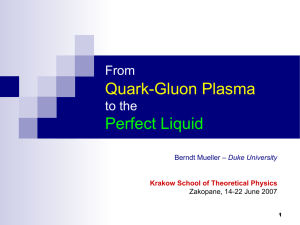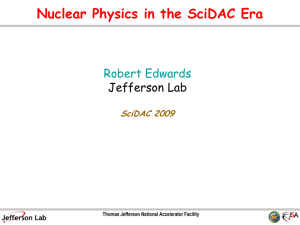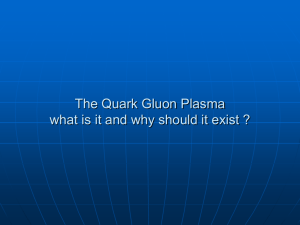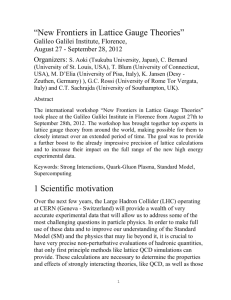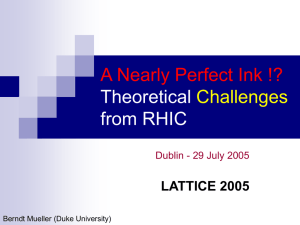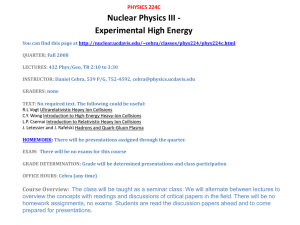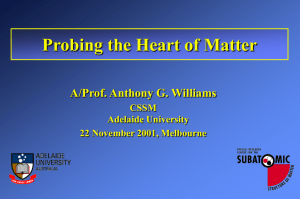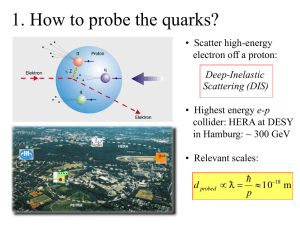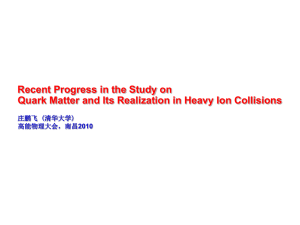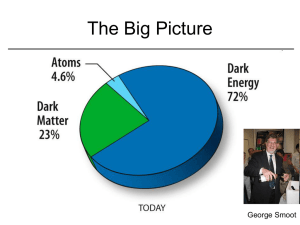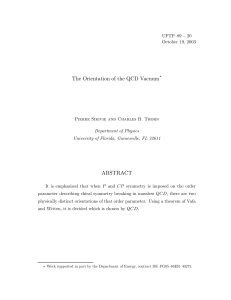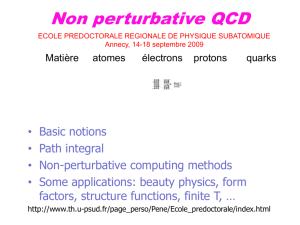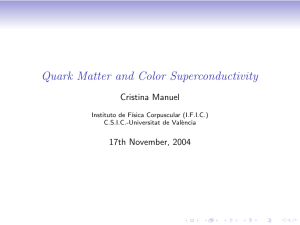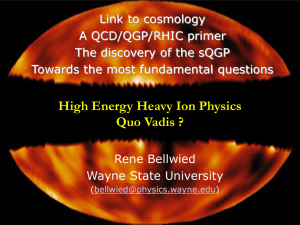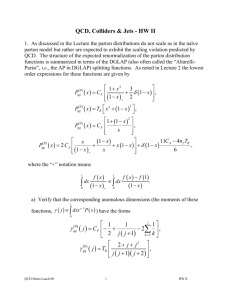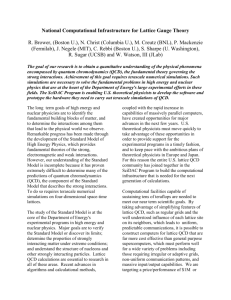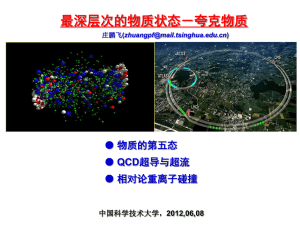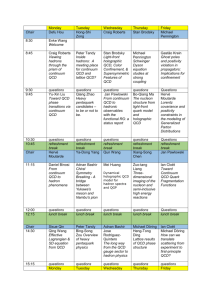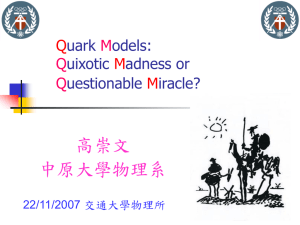Slide 1
advertisement
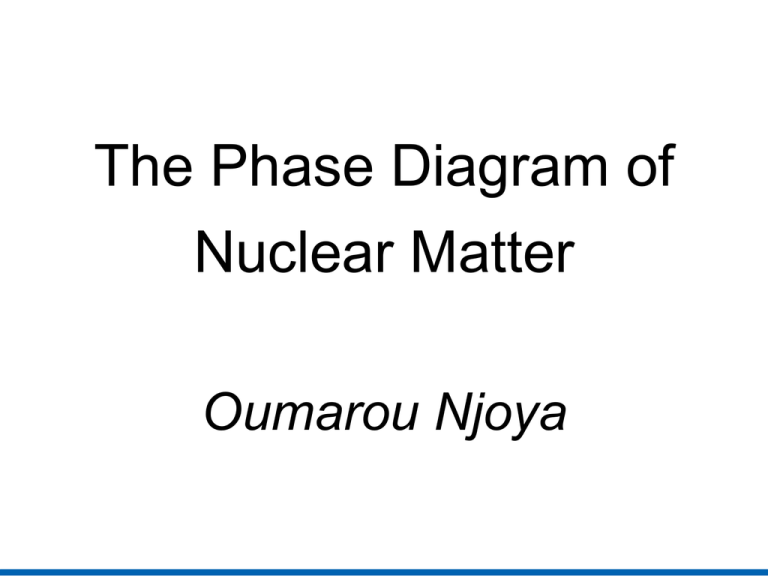
The Phase Diagram of Nuclear Matter Oumarou Njoya Outline Motivations for studying QCD phase transitions Introduction to QCD Mapping the phase diagram Experimental considerations Summary Motivations The Big bang Theory Neutron stars Discovery of strong force Forces and structures in Nature Gravity one “charge” (mass) force decreases with distance m1 m2 Electromagnetism two “charges” (+ / -) Atom force decreases with distance + - + + Atomic nuclei and the “nuclear” force Nuclei composed of: quark protons (+ electric charge) neutrons (no electric charge) neutron Do not fly apart!? “nuclear force” overcomes electrical repulsion determines nuclear reactions (stellar burning, bombs…) arises from fundamental strong force (#3) acts on color charge of quarks proton What is QCD? Quantum chromo-dynamics A theory of the strong (or nuclear, or color) force. Closely modeled on QED but with three conserved color charges: Quarks: r, g, b Anti quarks: anti-red, anti-green, anti-blue. Quarks scatter by exchanging gluons, which carry color and anticolor. More QCD Only colour singlet states can exist as free particles. Hadrons are colour singlet. Mesons: Baryons: Confinement (r ~ 1fm) Chiral symmetry Having to do with quark masses Asymptotic freedom (r → 0) Strong interaction becomes weaker at high energy Relativistic hot gas Confinement to study structure of an atom… electron nucleus neutral atom Confinement: fundamental & crucial (but not well understood!) feature of strong force - colored objects (quarks) have energy quark-antiquark pair in normal vacuum… QCD created from vacuum quark “white” proton (confined quarks) Strong color field “white” 0 “white” proton Energy grows with separation (confined quarks) !!! QCD Thermodynamics Relativistic kinematics of free gas. Partition function: bosons fermions A simple model Ideal gas of massless pions. Stefan-Boltzmann From hadrons to quarks and gluons Chiral symmetry argument Massless u and d implies chirally symmetric Lagrangian. Spontaneous symmetry breaking in ground state. Symmetry conserved at high T. Expect phase transition. (akin to Curie point in a ferromagnet). Pisarski-Wilzeck: 1st order transition Tricritical point Evidence suggests 1st order at high T and low μB At low T: nuclear matter Crossover and critical point Crossover for μB = 0. (Lattice QCD) Critical point Coexisting phases along 1st order line, similar to that of liquid in condensed matter physics Low-T high- μB: ordered quark phases exist Locating the critical point Theoretically simple (singularity of partition function). Importance sampling and sign problem. Lattice QCD. Lattice QCD • There are two order parameters Quarks and gluons are studied on a discrete space-time lattice 1. The Polyakov Loop 2. The Chiral Condensate Solves the problem of divergences in pQCD calculations (which arise due to loop diagrams) L ~ Fq ~ mq The lattice provides a natural momentum cut-off pure gauge = gluons only pmax , a pmin Ns a Recover the continuum limit by letting a 0 1 2s Order Parameters Deconfinement measure: Palyokov loop Effective quark mass Energy density є at deconfinement The phase diagram of QCD Early universe Temperature critical point ? quark-gluon plasma Tc hadron gas nucleon gas nuclei 0 vacuum baryon density Neutron stars Generating a deconfined state Present understanding of Quantum Chromodynamics (QCD) heating compression deconfined color matter Hadronic Nuclear Matter Matter Quark Gluon Plasma (confined)! deconfined Relativistic Heavy Ion Collider (RHIC) PHOBOS PHENIX 1 km RHIC BRAHMS STAR v = 0.99995c = 186,000 miles/sec AGS TANDEMS A few methods Hadron radiation Electromagnetic radiation Dissipation of a passing quarkonyum beam (fancy for Debye screening in nuclear matter) Energy loss of a passing jet. Hadron radiation Formed at the transition surface between hot matter and physical vacuum. At Tc local hadronization occurs. Mostly pions, kaons, nucleons and anti-nucleons. Study of relative abundances gives us information about hadronization temperature. Electromagnetic radiation Spectra of photons and leptons provide information about the state of the medium at the time they were formed. Consider for illustration μ+μ- formation Summary Mapping the QCD phase diagram is important for understanding the early evolution of the universe and the physics of neutron star. QCD thermodynamics suggests a well-defined transition from hadronic matter to a plasma of deconfined quarks and gluons. The nature and the origin of the transition at high needs to be clarified further. The properties of the QGP can be explored through hard probes. Certainly, lots of new physics await discovery. Bibliography M. Stephanov, [arXiv:hep-lat/0701002v1] Helmut Satz, [arXiv:0903.2778v1 [hep-ph]] Peter G Jones, Introduction to QCD, rhic.physics.wayne.edu/~bellwied/classes/phy707 0/QCD-lecture.ppt Slides 5,8,17,18 were borrowed from Gang Wang (UCLA). Thank you!
